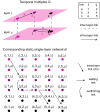Betweenness centrality for temporal multiplexes
- PMID: 33649386
- PMCID: PMC7921680
- DOI: 10.1038/s41598-021-84418-z
Betweenness centrality for temporal multiplexes
Abstract
Betweenness centrality quantifies the importance of a vertex for the information flow in a network. The standard betweenness centrality applies to static single-layer networks, but many real world networks are both dynamic and made of several layers. We propose a definition of betweenness centrality for temporal multiplexes. This definition accounts for the topological and temporal structure and for the duration of paths in the determination of the shortest paths. We propose an algorithm to compute the new metric using a mapping to a static graph. We apply the metric to a dataset of [Formula: see text]k European flights and compare the results with those obtained with static or single-layer metrics. The differences in the airports rankings highlight the importance of considering the temporal multiplex structure and an appropriate distance metric.
Conflict of interest statement
The authors declare no competing interests.
Figures




References
Grants and funding
LinkOut - more resources
Full Text Sources
Other Literature Sources

